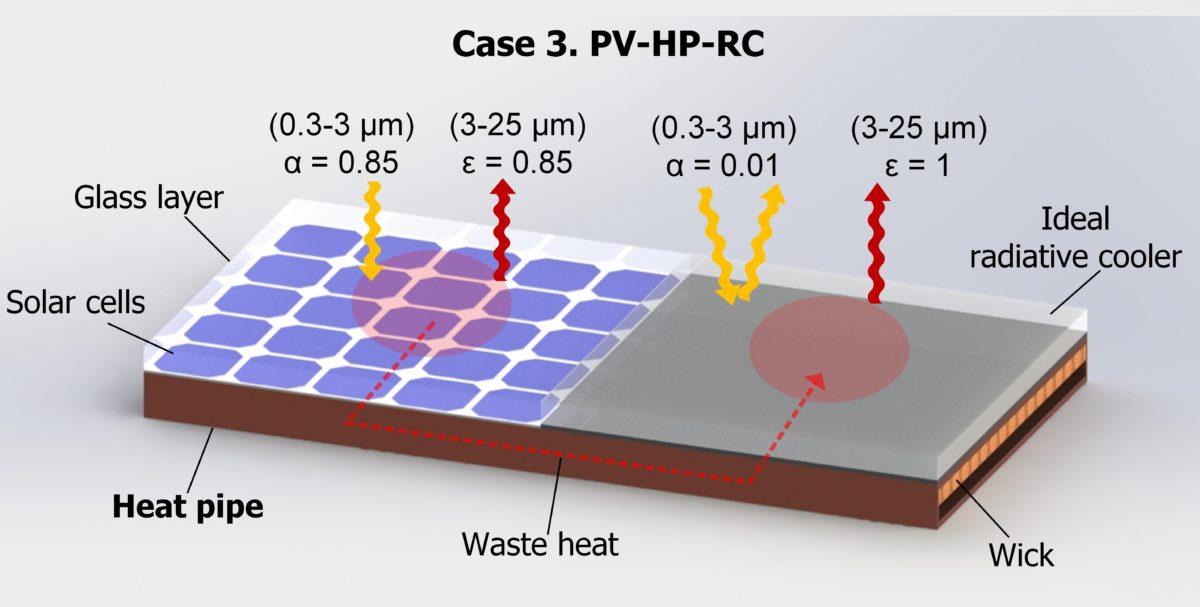Researchers from Zhejiang University and Shanghai Jiao Tong University in China have developed a hybrid solar module cooling technique based on radiative cooling (RC) and the use of heat pipes to transfer heat.
“Many studies had investigated radiative cooling of photovoltaics by replacing the usual glass cover with highly emissive RC coatings on top of the solar cells,” researcher Salman Ahmed told pv magazine. “However, it was observed that this replacement only reduced the cell temperature by around 1 C to 2 C.”
He claimed that this minimal temperature reduction depends on the usual 3.2 mm glass cover used for solar cell encapsulation, which features about 70% silica and gives it a relatively higher built-in thermal emissivity. As a result, even if the glass covers are replaced with ideally emissive radiative coolers on top, the reduction in solar cell temperature is not considerable.
“Therefore, spectrally modifying the existing PV module covers or substituting them with novel RC materials is inefficient for passive PV cooling,” Ahmed explained.
He said that three main requirements should be fulfilled to improve the cooling effect. The radiative coolers should not replace the existing PV glass covers, so the natural RC ability of glass can be harnessed to add to the overall cooling gain. There should also be an efficient and quick heat transfer mechanism between the PV module, which is also the heat source, and the RC heat sink. In addition, the RC module should directly face the sky to radiate maximum waste heat into outer space.
The proposed system consists of a PV module and a separate RC module, integrated with a flat plate heat pipe in between. A separate RC module is used along with the existing glass cover on the solar cells and the heat pipe is integrated between the PV and RC modules, providing quick heat transfer. The RC module is then placed on the condensing section of the heat pipe facing the sky.
“The PV module is placed on the evaporating section and waste heat from the cells is radiated out simultaneously from both the RC module and the usual glass cover,” Ahmed said. “As a result, a significant reduction in solar cell operating temperature and a rise in electrical efficiency are obtained.”The performance of the system was tested through a thermal model and numerical simulations by varying the external and internal input parameters and their effects on performance indicators.
“The maximum solar cell operating temperature reduction for the proposed system compared to the conventional glass encapsulated PV system was 12.86 C,” Ahmed said. “This corresponds to a relative rise in the electrical efficiency of 7.25%.”
The researchers plan to investigate how to further reduce system costs.
“Heat pipe fabrication is expensive and significantly adds to the overall system costs,” Ahmed said. “We plan to work on experimental verification for our proposed work in the future.”
They discussed their findings in “Enhanced radiative cooling of solar cells by integration with heat pipe,” which was recently published in Applied Energy.
Researchers from Purdue University, the Catalan Institute of Nanoscience and Nanotechnology and the Instituto de Ciencia de Materiales, and the Jordan University of Science and Technology and the Australian College of Kuwait have also recently applied radiative cooling to solar panel cooling. In addition, scientists at Shanghai Jiao Tong University recently conducted a review of the possible combinations between radiative cooling techniques.
This content is protected by copyright and may not be reused. If you want to cooperate with us and would like to reuse some of our content, please contact: editors@pv-magazine.com.




Cool! I like this idea. I also work on radiative cooling modules in combination with PV and also on different floating and ground mounted structures in combination with radiative cooling modules. you are free to contact me. I also work on patent these technics here in austria. Investors and partners are warmly welcome.